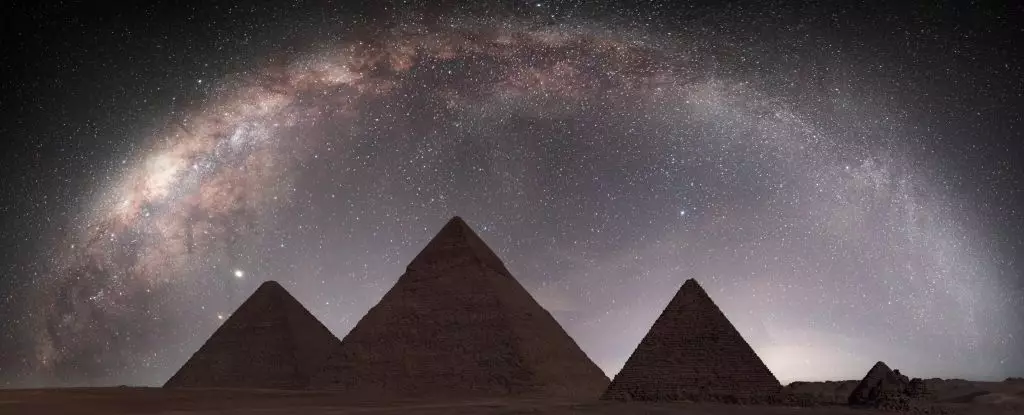In the realm of ancient civilizations, few cultures have struck a chord with humanity’s fascination for the heavens as ancient Egypt has. Recent revelations indicate that this fascination might date back thousands of years, as evidenced by profound representations of cosmic phenomena in the artwork of the time. Astrophysicist Or Graur’s groundbreaking analysis posits that the iconic goddess Nut, often depicted in Egyptian art, may serve as a bridge between earthly life and the celestial wonders above. His research reveals a deeper narrative that intertwines mythology, astronomy, and art—inviting us to marvel at how ancient civilizations perceived their cosmos.
Nut, the Egyptian goddess of the sky, is frequently portrayed in funeral art, arching protectively over the deceased as they embark on their journey into the afterlife. Her body, often marked with stars and celestial symbols, serves as a canvas of cosmic interpretation. Graur’s research delves into the fascinating possibility that these depictions encapsulate the structure of the Milky Way, specifically its galactic plane, which is adorned with a distinctive band of dust. This presents a riveting intersection between art and science, opening questions about the motivations behind these representations in a society deeply rooted in spirituality.
The Cosmic Canvas: Analyzing Depictions of Nut
Graur’s meticulous study of over hundreds of coffins reveals artwork rich with stylistic nuances that may allude to the Milky Way. This endeavor is not merely an academic exercise but a quest for understanding the ancient Egyptians’ worldview. His insights illuminate a compelling hypothesis—whether the undulating line often depicted along Nut’s form symbolizes the Great Rift, the dark band of cosmic dust cutting through the luminous arc of the Milky Way. This visualization invites a fresh perspective on how ancient Egyptian art transcended its era, possibly echoing the vast cosmic realities observed even today.
One insightful finding comes from the coffin of Nesitaudjatakhet, a priestess from the 21st Dynasty. The depiction of Nut on her sarcophagus features this intriguing sinuous line, seemingly echoing the brightness of the stars depicted on either side. Graur passionately argues that this correspondence is more than coincidental; it hints at an ancient understanding of cosmic alignments, perhaps even foreshadowing our contemporary appreciation for the structured artistry of the universe. Such artistic representations, far from being purely ornamental, may hold a narrative rich in symbol and significance.
Distinctive Rarity in Artifact Representations
Graur’s findings note a curious rarity surrounding these cosmic symbols in depictions of Nut. Upon thorough examination, he identifies only four other instances featuring similar undulating lines, underscoring that this particular representation of the Milky Way is not a common theme in the broader corpus of Nut’s imagery. For instance, while she is represented in various forms throughout the tombs of notable pharaohs like Ramesses IV, VI, and IX, the absence of wavy lines suggests a nuanced distinction between Nut and the celestial elements she embodies.
This distinction captivates the imagination, suggesting that while Nut may be associated with cosmic phenomena, she is not merely an embodiment of the Milky Way itself, but rather interacts with it, presenting an evolution of her character as a protector of souls traversing both the earthly and astral realms. By reframing Nut against the backdrop of the cosmos, Graur ignites an essential dialogue about the intersection between spirituality, mythology, and scientific inquiry—shaping our understandings of these legacies.
Interdisciplinary Bridges: New Perspectives Through Collaboration
The implications of Graur’s research transcend mere academic interest. They highlight the importance of interdisciplinary scholarship, merging the fields of archaeology, astronomy, and art history to forge new pathways of understanding ancient cultures. By harnessing insights from various disciplines, researchers can enrich our grasp of the cultural context surrounding artifacts and their creators.
Moreover, Graur’s work serves as a clarion call for enhanced accessibility to museum collections globally. Encouraging the digitization of resources, he emphasizes the necessity for modern tools to unveil artifacts to a broader audience, making the wonders of ancient civilizations accessible to enthusiasts, scholars, and curious minds alike. This democratization of knowledge reinforces the notion that the treasures of the past can continue to inspire current and future generations.
As we ponder the delicate balance of myth and astronomy reflected in ancient Egyptian art, we embark on a journey of discovery fueled by curiosity and reverence for the cosmos. Through the lens of history, we witness how artistry and science converge, allowing us to engage with the past in ways that bring the vibrant tapestry of human existence to life in stunning clarity.

